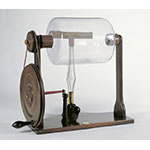Typical example of cylinder frictional electrical machine made in England in the last decades of the eighteenth century. Described by Tiberius Cavallo, but the leading maker of this design was George Adams Junior.
The glass cylinder can be rotated rapidly by means of the multiplying-wheel arrangement. Rather unusually, the multiplying wheel has a long axle with its own support. In the common arrangement, the wheel is simply attached to one of the uprights supporting the glass cylinder. This alteration may have been made to prevent excessive vibration. The leather cushion is fixed to a shaped glass pillar and, to increase friction, can be pressed against the cylinder by means of a long screw. The separate prime conductor is missing—a usual occurrence with this type of machine. Provenance: Lorraine collections.










